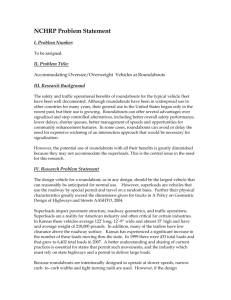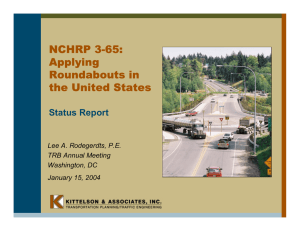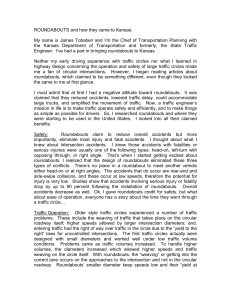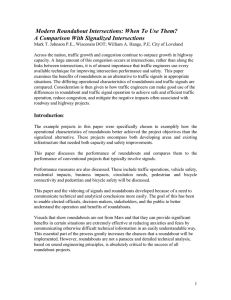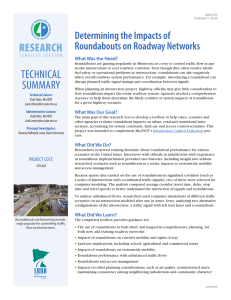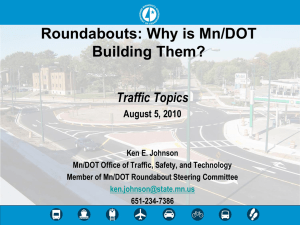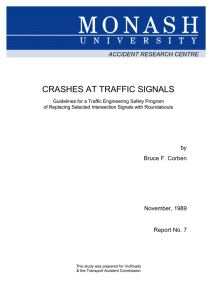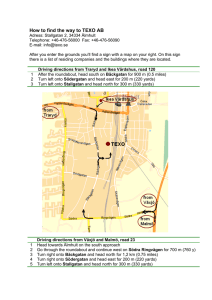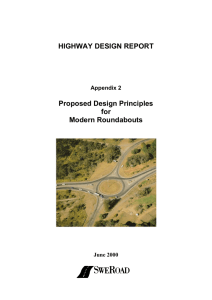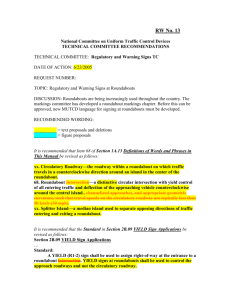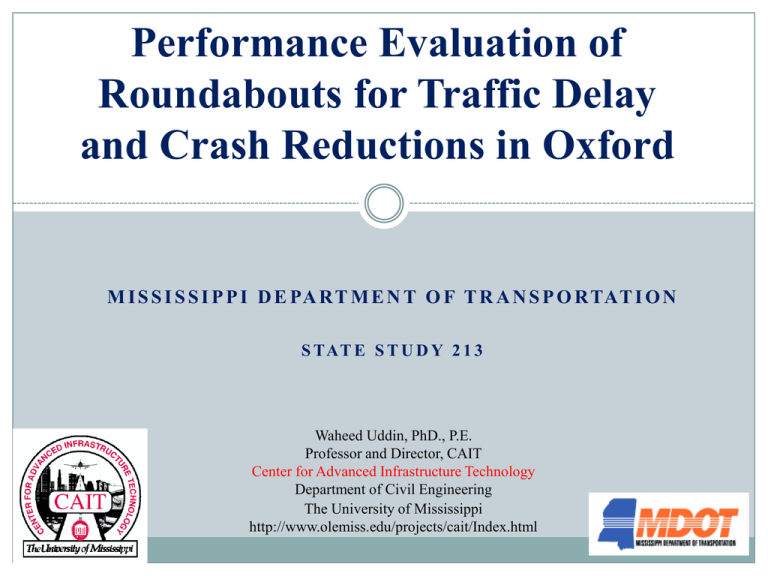
Performance Evaluation of
Roundabouts for Traffic Delay
and Crash Reductions in Oxford
M I S S I S S I P P I D E PA R T M E N T O F T R A N S P O R TAT I O N
S TAT E S T U D Y 2 1 3
Waheed Uddin, PhD., P.E.
Professor and Director, CAIT
Center for Advanced Infrastructure Technology
Department of Civil Engineering
The University of Mississippi
http://www.olemiss.edu/projects/cait/Index.html
Project Overview
The overall goal of this study is to assess the performance of a double roundabout
interchange at the South Lamer Boulevard Exit on Highway 6 with respect to traffic
flow, capacity, safety improvements, benefit/cost, and public opinion.
Task 1 ─ Collect and Review Pre-roundabout Data
Historical traffic and historical crash data – Provided by MDOT
Prior studies –Traffic and Planning Studies (Completed by Neel-Schaffer on behalf of MDOT)
Plans - (Provided by MDOT)
Task 2 ─ Collect and Analyze Post-roundabout Data
Current available traffic and crash data – Provided by MDOT
On-site traffic data collection – completed by engineering students
Traffic analysis of current traffic data – completed by Graduate student
Task 3 ─ Conduct Road Users’ and Public Survey
Anonymous on-site and telephone surveys
Task 4 ─ Submit and Present Interim Report
Task 5 ─ Finalize Data Collection, Complete Analysis, and Evaluate Results
Task 6 ─ Final Report
2
Highway 6 and South Lamar Avenue Interchange
Prior to the roundabout construction the
interchange experienced extreme delay,
was a safety concern, and was projected
to exceed capacity limitation by 2016.
Planned roundabouts on South
Lamar Blvd.
(courtesy of James Sullivan, MDOT)
The signalized and stop controlled
intersections were replaced with a double
roundabout interchange, a full roundabout on
one side and a teardrop shape on the other.
Current roundabout on South Lamar Blvd.
(Google Earth)
3
Total Vehicles per Hour for North and South Bound
Traffic Data
Collected by The
University of Mississippi
Engineering Students
Dates of Collection:
October 12 – 17, 2009
Collection time: 7:00
AM to 7:00 PM
Collection intervals: 15
minute
Vehicle Class
Distribution:
Motorcycle, Truck, Bus,
Passenger Car
Total VPH North Bound
Total VPH South Bound
Total VPH
2000
Vehicles per Hour
Intersection of Hwy 6
Ramps and South
Lamar Avenue
2500
1500
1000
500
0
7:00
8:00
9:00
10:00
11:00
12:00
1:00
2:00
3:00
Hour
AM
PM
4:00
5:00
6:00
Traffic Analysis Results
from microsimulation software
Delay and Speed Results
Queuing Results
Environmental
Impacts of
Roundabouts
Decrease in vehicular
emissions and fuel
consumption by reducing
idling time at intersection
Vehicles stopping at
traffic signals and stop
signs emit more CO2
when compared to
vehicles at roundabouts as
the delay and queuing are
greater
When vehicles are idle in
a queue they emit about 7
times as much CO as
vehicles traveling at 10
mph. The emissions from
a stopped vehicle are
about 4.5 times greater
than a vehicle moving at 5
mph [environmental
impacts of modern
roundabouts]
Emission Rates by Speed and LOS for Light-Duty Vehicles and Trucks g/veh/mi
Air Pollutant Emissions For Pre- and Post - Roundabout*
Air Pollutant
Stop - Controlled Intersection Roundabout Intersection
VOC emissions (g/hr)
6,030
1,399
CO emissions (g/hr)
89,535
20,779
NOx emissions (g/hr)
4,484
1,041
PM 10 emissions (g/hr)
439
101
* Emission values based on traffic data and speeds from Microsimulation Software.
What Makes Roundabouts Safer?
Stop Controlled
Intersection
25 Contact Points
• Less Contact Points
• Lower Travel Speeds
Roundabout
7 Contact Points
• Geometry
• Calmer Drive
Crash data for Highway 6 and South Lamar
Interchange
Crash Reduction Pre- and
Post- Roundabout
AM and PM Crash Data
JH_Oxford_Crash_Data_SL.xls
Crash Data for the Highway 6 and South Lamar Intersection
Average Number of Crashes per Half a Year Pre- and Post- Roundabout
6
12
5am - 5pm
5pm- 5am
5
8
PostRoundabout
6
4
Average Number of Crashes per 6 Months
10
Number of Crashes
Jessica Headrick_9.11.09
4
3
2
1
2
0
0
2004
2005
2006
2007
2008
Pre-Roundabout
Post-Roundabout
1
Year
Daytime crashes were significantly
reduced in the first year of the roundabout
opening to traffic.
The t-test concludes that the installment
of the roundabouts do have a significant
effect on the number of crashes reduced.
Public Opinion
Survey
Locations of collection:
On-site at two convenience
stores adjacent to the
roundabouts
Random telephone and e-mail
surveys
Factors:
Age
Familiarity
Favorability
Results showed overwhelming
approval of the roundabouts
and support construction of
more roundabouts.
Respondents commented…to
install improved signage
including flashing lights and
additional pavement markings,
especially at the south
roundabout.
Performance Analysis of Roundabouts
Since the replacement of the signal controlled
interchange with the roundabout interchange:
Driver delay has reduced by 24%.
Driver idling time has reduced by 77%.
Driver fuel wastage has reduced by 56%.
Travel time through the interchange has
increased by 67%, saving drivers approximately
$806,018 annually*.
Crashes and crash related injuries have been
significantly reduced savings an annual
comprehensive cost of $86,008 U.S. dollars.
Drivers favor the roundabouts over the
signalized intersections at this location.
*Annual total of all vehicles through the interchange.
10

